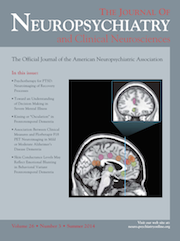Psychosis in children younger than age 15 years is very rare.
1 The common form is early onset schizophrenia, defined as the children suffered from schizophrenia during onset age between 7 and 14 years. The prevalence rate of early onset schizophrenia is rare (10 in 100,000 children)
2; this is much less than those of adult-onset schizophrenia.
3 Another form of childhood psychosis is called transient psychosis, which is also rare with a prevalence rate 9.6 per 100,000 children.
4 Children with transient psychosis have severe and vivid psychotic symptoms, and these symptoms persist for a short duration, mostly caused by outside visible etiology.
Upper respiratory infection (URI) is one of the most common childhood diseases. In the literature, there were some reports of “acute psychosis after influenza virus infection.” For example, patients with influenza virus infection had a sevenfold increased risk of schizophrenia by maternal influenza infection.
5 Similarly, transient neuropsychiatric symptoms were noted after influenza in children had already sporadically reported in various countries.
6–15 Furthermore, some pediatric neurologists had reported psychotic symptoms after childhood viral encephalopathy, e.g., Hashimoto encephalopathy
16 and Epstein-Barr (EB) virus infection.
17 Therefore, influenza virus infection among children and adolescents might be relevant with acute psychosis. However, there are no reports on transient childhood psychosis after URI. We report two children suffering from psychosis after URI by brief history, disease course, and treatment.
Case Report
Case #1
A 14-year-old boy without a family history of psychiatric illness was admitted to the pediatric ward via the emergency room because of auditory hallucination for 2 days. He also had a deluded complaint of a “broken neck”; he walked with bizarre gestures to keep his neck stiff. He also complained of all his blood flowing into his legs, causing him to become an empty body and being seized by an outside source, preventing him from moving freely. The above-mentioned psychotic symptoms began immediately after the influenza virus infection.
The laboratory data were relatively normal, including EEG report, MRI, rapid influenza test, EB virus, mycoplasma, herpes simplex virus screen as well as elevated C-reactive protein (5.43 mg/dl), and mild anemia with hemoglobin of 12.2 g/dl.
On assumption of psychosis after URI, an antipsychotic agent was prescribed, and the psychotic symptoms resolved after 1 month. These psychotic symptoms did not recur, even though antipsychotic drugs were no longer administered.
Case #2
A 12-year-old boy was hospitalized in the pediatric ward because of URI with acute gastritis for 3 days. He experienced a strange, empty, and unrealistic feeling 3 days after discharge from the pediatric ward. Although the patient was previously hyperactive, he began to fear leaving home, and his parents obviously felt he had a severe personality change. His parents were extremely concerned about his bizarre empty, unrealistic feeling.
An antipsychotic agent was prescribed under the assumption of psychosis after URI, and symptoms resolved after 5 days of antipsychotic drug therapy. No recurrence was confirmed by the child psychiatrist in a telephone intervention.
Discussion
In addition to the aforementioned two cases, we have seen many cases during the past 10 years of clinical child and adolescent psychiatric practice. We searched patient chart numbers with various psychosis-related ICD diagnostic code, such as 295 (schizophrenia), 293 (delirium), 294 (organic brain syndrome), 297 (delusional disorder), and 298 (atypical psychosis) during past 10 years (from Dec. 2000 to Jan. 2011) under the author’s clinical assumption. The study reviewing the charts was approved by the Institutional Review Boards of the Mackay Memorial Hospital.
We found 60 patients with psychosis-related diagnosis. Among them, we found 21 (35%) had psychosis after URI, 19 (31.7%) had schizophrenia, 10 (16.7%) had mental retardation with psychotic feature, 8 (13.3%) had psychosis attributable to general medical condition, and 2 (3.3%) had psychosis with unknown etiology. According to the medical records, the 21 patients under assumption of psychosis after URI were treated with antipsychotic drugs, and their symptoms resolved within 1 month. All of them did not come back for further antipsychotic treatment.
In our case reports, the psychotic symptoms after URI were substantially different from those in children with early onset schizophrenia. The symptoms are characterized by acute onset without any premorbid social deterioration or withdrawal symptoms. In addition, the symptom severity and prognosis are better than those in childhood onset schizophrenia. Unfortunately, the underlying pathology of psychosis after URI remains unexplored. These reported cases might be classified as “URI-associated acute psychosis” if the patients have direct influenza antibody titer, vivid psychotic symptoms, and significant neuroimaging study findings as well as symptoms of acute URI.
In our case reports, acute psychotic symptoms resolved by antipsychotics within 4 weeks. Treating transient psychosis after URI is usually pharmacologically manageable and effective. We should recognize this transient psychosis from childhood onset schizophrenia and treat them immediately.
In summary, our case reports, within 10 years of experience, suggest an association between psychotic mental change and presentation with URI. The psychotic symptoms might further be exaggerated, if treatment with antipsychotic agent is delayed. It is warranted to conduct a study to explore and confirm the association between psychosis and URI. The underlying mechanisms should also be further explored.

